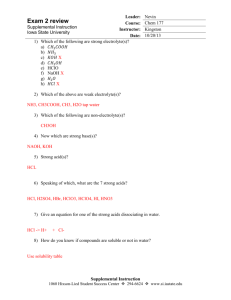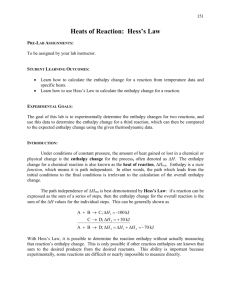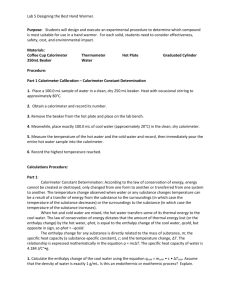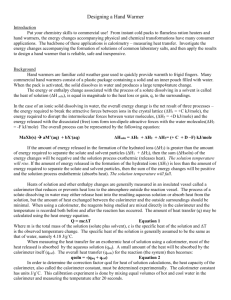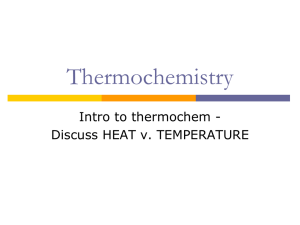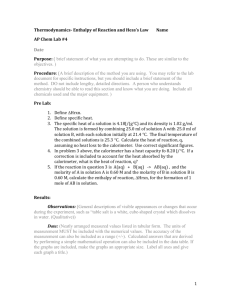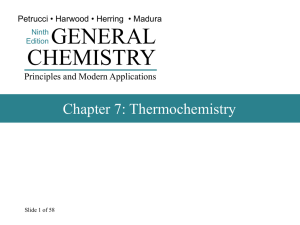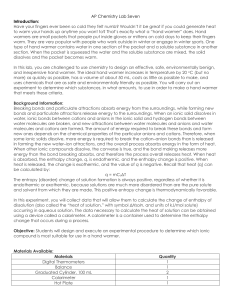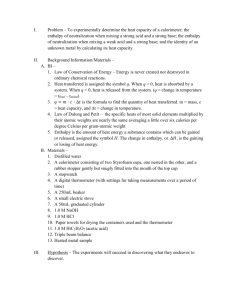13 Hess`s Law.
advertisement
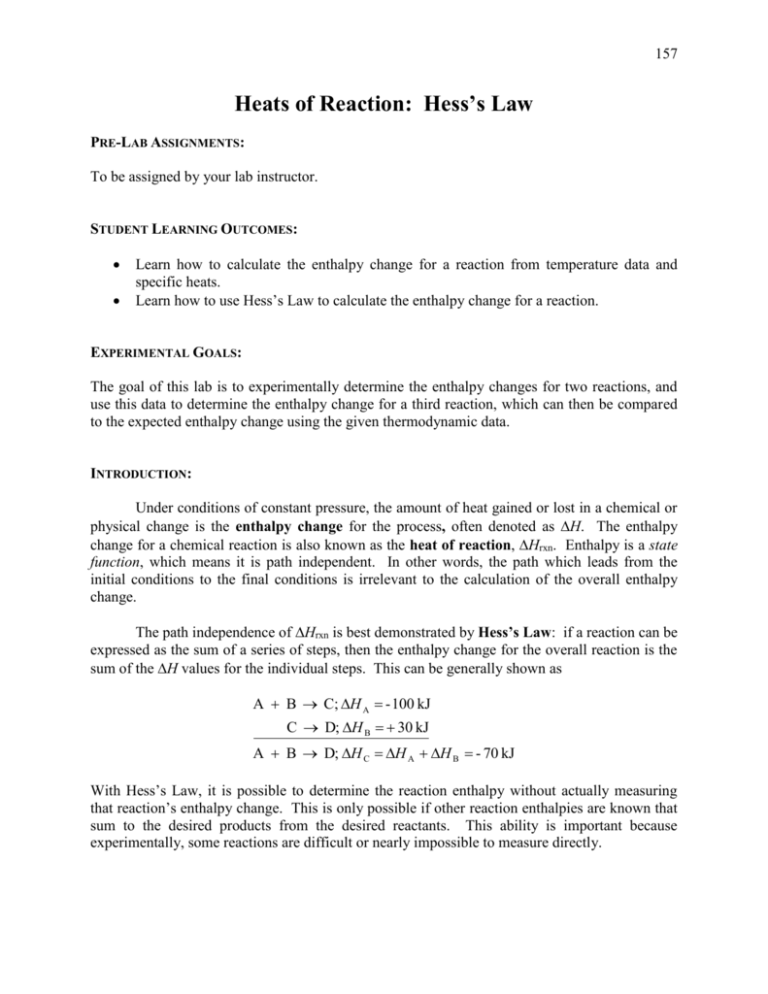
157 Heats of Reaction: Hess’s Law PRE-LAB ASSIGNMENTS: To be assigned by your lab instructor. STUDENT LEARNING OUTCOMES: Learn how to calculate the enthalpy change for a reaction from temperature data and specific heats. Learn how to use Hess’s Law to calculate the enthalpy change for a reaction. EXPERIMENTAL GOALS: The goal of this lab is to experimentally determine the enthalpy changes for two reactions, and use this data to determine the enthalpy change for a third reaction, which can then be compared to the expected enthalpy change using the given thermodynamic data. INTRODUCTION: Under conditions of constant pressure, the amount of heat gained or lost in a chemical or physical change is the enthalpy change for the process, often denoted as H. The enthalpy change for a chemical reaction is also known as the heat of reaction, Hrxn. Enthalpy is a state function, which means it is path independent. In other words, the path which leads from the initial conditions to the final conditions is irrelevant to the calculation of the overall enthalpy change. The path independence of Hrxn is best demonstrated by Hess’s Law: if a reaction can be expressed as the sum of a series of steps, then the enthalpy change for the overall reaction is the sum of the H values for the individual steps. This can be generally shown as A B C; H A - 100 kJ C D; H B 30 kJ A B D; H C H A H B - 70 kJ With Hess’s Law, it is possible to determine the reaction enthalpy without actually measuring that reaction’s enthalpy change. This is only possible if other reaction enthalpies are known that sum to the desired products from the desired reactants. This ability is important because experimentally, some reactions are difficult or nearly impossible to measure directly. 158 In this experiment the enthalpy changes for two chemical reactions will be measured, and the results will be used to calculate the enthalpy change for a third chemical reaction using Hess’s Law. The reactions for which H will be measured are: I. H+(aq) + OH-(aq) H2O(l) II. Mg(s) + 2H+(aq) Mg2+(aq) + H2(g) From these measurements, H will be calculated for reaction III: III. Mg(s) + 2H2O(l) Mg2+(aq) + 2OH-(aq) + H2(g) Since reactions I and II are exothermic, the measured value for their H’s will be negative. Each heat of reaction is obtained by assuming that all of the heat liberated by the reaction (Hrxn) goes toward heating up the solution containing the reacting chemicals (H1) and the container (H2): reactants products heat liberated, qrxn heat absorbed by solution, qsoln solution heat absorbed by container, qcal calorimeter Since the solution and container are absorbing heat, both qsoln and qcal are positive, and are given by the formulas qsoln = Cs,soln m ΔT qcal = Ccal ΔT where Cs,soln is the specific heat of the solution, Ccal is the heat capacity of the container, m is the mass of the solution, and ΔT is the change in temperature (ΔT = Tfinal – Tinitial). The heat of the reaction, qrxn, is calculated from the equation qrxn = -(qsoln + qcal) When the chemicals are mixed, the temperature of the solution and container will rise, then start to fall when the reaction is complete. While the temperature is rising, some of the heat will be lost to the surroundings, and will not be available to warm the solution. To correct for this, a graph is made of the temperature vs. time; when this graph is extrapolated back to zero time (time of mixing), the correct (maximum) final temperature, Tf, can be obtained, which is the value that is used to calculate ΔT. (See Figure 1.) 159 Tf Temperature, °C 32° 30° 28° 26° 24° 0 1 2 3 4 Time, min Figure 1. Graph of time vs. temperature used to determine Tf. split stopper clamp thermometer stirrer lid 2 nested Styrofoam cups Figure 2. Calorimeter setup. 5 160 PROCEDURE: I. H+ + OH- H2O a. Weigh an empty, dry coffee cup calorimeter made by nesting two Styrofoam cups together. Using a graduated cylinder, measure 48.0 mL of 2.0 M HCl and add it to the calorimeter. b. Measure 50.0 mL of 2.0 M NaOH and place it in a 150 mL beaker. Allow this solution to sit for about five minutes. c. Using a thermometer, determine the temperature of the HCl solution in the calorimeter to the nearest 0.1 oC. Clean and dry the thermometer to measure the temperature of the NaOH solution. These solutions should have the same or very close to the same temperature. Take the average of these two temperatures as your initial temperature, Ti. d. Now assemble the calorimeter. Insert the thermometer into the split stopper; slide the stopper toward the top of the thermometer. Slide the thermometer into the center hole of the calorimeter lid. Place the ring stand clamp on the stopper, and adjust the clamp on the ring stand to where it will hold the thermometer bulb about 1 cm from the bottom of the cup. Insert the stirrer in the second hole of the lid with the loop encircling the bulb of the thermometer. (See Figure 2.) e. Be ready to start timing and recording temperatures as soon as you mix the acid and base. Rapidly add the NaOH solution to the HCl solution in the calorimeter, being careful not to splash any on the upper sides of the calorimeter. Note the time of adding, close the lid, begin stirring, and read the thermometer to the nearest 0.1°C every 10 seconds for the first 90 seconds, and then every 30 seconds until a total of 5 minutes has elapsed. f. When the above procedure is completed, weigh the calorimeter and its contents, empty the solution into the sink, and rinse and dry the calorimeter and thermometer to prepare for the second reaction. II. Mg + 2H+ Mg2+ + H2 a. Re-weigh the empty, dry calorimeter. b. Measure 50.0 mL of 2.0 M HCl into the calorimeter. Measure and record the temperature of the HCl. This will be Ti. c. Accurately weigh about 0.5 g of Mg turnings onto a piece of weighing paper. d. Assemble the calorimeter and thermometer as in part I, and add the Mg to the HCl. Stir and record the temperatures as in part I. e. When the reaction is completed, weigh the calorimeter and contents, empty the solution into the sink, and rinse and dry the calorimeter and thermometer. 161 III. Calculations. a. H+ + OH- H2O 1. Plot the temperature of the reaction mixture versus time after mixing. The graph should be expanded as much as possible: the lowest temperature you recorded during the run should be near the bottom of the graph paper, and the highest temperature should be somewhere near the middle of the graph paper. (Do not graph the initial temperature! This will compress the scale of the graph too much.) Using a straight edge, draw a straight line that falls closest to the most points on the later part of the curve. (See Figure 1.) Extend the straight line to cross the y-axis at time t = 0, the time of mixing. From this intercept (Tf), and the initial temperature (Ti), calculate ΔT. 2. Calculate qsoln, the heat absorbed by the solution (qsoln = Cs,soln m ΔT). Since the solution is relatively dilute, we can use the specific heat of water, 4.18 J g-1 °C-1, as Cs,soln. 3. Calculate qcal, the heat absorbed by the container (qcal = Ccal ΔT). The heat capacity of the container, Ccal, is 8.36 J °C-1. 4. Calculate qrxn [qrxn = -(qsoln + qcal)]. 5. Calculate the number of moles of H+ (HCl) reacted, and divide qrxn by the number of moles of H+ to obtain ΔHI. b. Mg + 2H+ Mg2+ + H2 1. Plot the temperature of the reaction mixture versus time after mixing. Using a straight edge, draw a straight line that falls closest to the most points on the later part of the curve. Extend the straight line to cross the y-axis at time t = 0, the time of mixing. From this intercept (Tf), and the initial temperature (Ti), calculate ΔT. 2. Calculate qcal, the heat absorbed by the solution (qsoln = Cs,soln m ΔT). Since the solution is relatively dilute, we can use the specific heat of water, 4.18 J g-1 °C-1, as Cs, soln. 3. Calculate qcal, the heat absorbed by the container (qcal = Ccal ΔT). The heat capacity of the container, Ccal, is 8.36 J °C-1. 4. Calculate qrxn [qrxn = -(qsoln + qcal)]. 5. Calculate the number of moles of Mg and divide qrxn by the number of moles of Mg to obtain ΔHII. 162 c. Mg + 2H2O Mg2+ + 2OH- + H2 1. Write the thermochemical equations for reactions I and II (i.e., the balanced equation along with the H of the reaction). 2. Using Hess’s Law and your values for ΔHI and ΔHII for reactions I and II, calculate ΔHIII for reaction III: III. Mg(s) + 2H2O(l) Mg2+(aq) + 2OH-(aq) + H2(g) 2. Using the heats of formation (Hf°) below, calculate the “true” value of ΔHIII. Hf° (heat of formation, kJ/mol) Mg 0 H2O -285.8 Mg2+: -467.0 OH-: -230.0 H2: 0 4. Calculate the % error between your value and the true value: % error (your valu e - true value) 100 true value 163 LAB REPORT: Heats of Reaction — Hess’s Law Name ________________________________ Date _________ Partner ________________________________ Section _________ Report Grade ______ I. H+ + OH- H2O 1. Temperature of HCl (Ti) _______________ 2. Weight of calorimeter + solution _______________ 3. Weight of empty, dry calorimeter _______________ 4. Weight of solution _______________ 5. Volume of 2.0 M HCl _______________ 6. Temperatures of reaction mixture at: 0 s (Ti) 10 s 20 s 30 s 40 s 50 s 60 s 70 s 80 s 90 s 2.0 min 2.5 min 3.0 min 3.5 min 4.0 min 4.5 min 5.0 min 7. Tf (extrapolated from graph) _______________ 8. ΔT _______________ 9. qrxn (show calculations) _______________ 10. ΔHI (= qrxn / moles H+) _______________ 164 II. Mg + 2H+ Mg2+ + H2 11. Temperature of HCl (Ti) _______________ 12. Weight of calorimeter + solution _______________ 13. Weight of empty, dry calorimeter _______________ 14. Weight of solution _______________ 15. Weight of Mg _______________ 16. Temperatures of reaction mixture at: 0 s (Ti) 10 s 20 s 30 s 40 s 50 s 60 s 70 s 80 s 90 s 2.0 min 2.5 min 3.0 min 3.5 min 4.0 min 4.5 min 5.0 min 17. Tf (extrapolated from graph) _______________ 18. ΔT _______________ 19. qrxn (show calculations) _______________ 20. ΔHII (= qrxn / moles Mg) _______________ 165 III. Mg + 2H2O Mg2+ + 2OH- + H2 21. Thermochemical equations for reactions I and II: 22. ΔHIII for Mg + 2H2O Mg2+ + 2OH- + H2 (calculated from ΔHI and ΔHII using Hess’s law) (show calculations) _______________ 23. ΔHIII for Mg + 2H2O Mg2+ + 2OH- + H2 (calculated from heats of formation) (show calculations) _______________ 24. % error (your valu e - true value) 100 true value _______________ 166 167 Name ________________________________ 168 Name ________________________________
